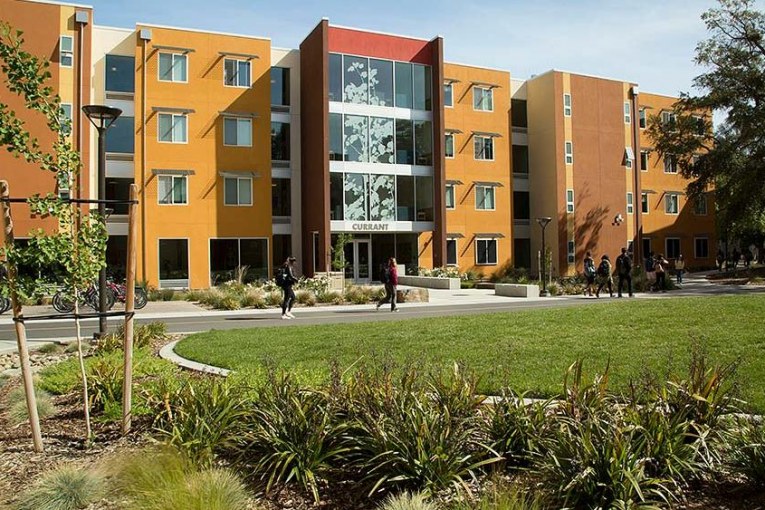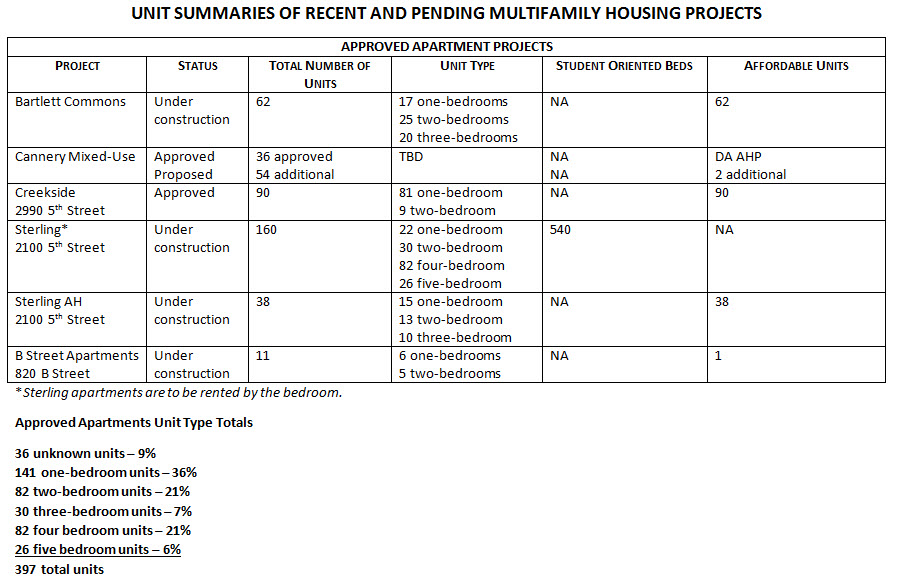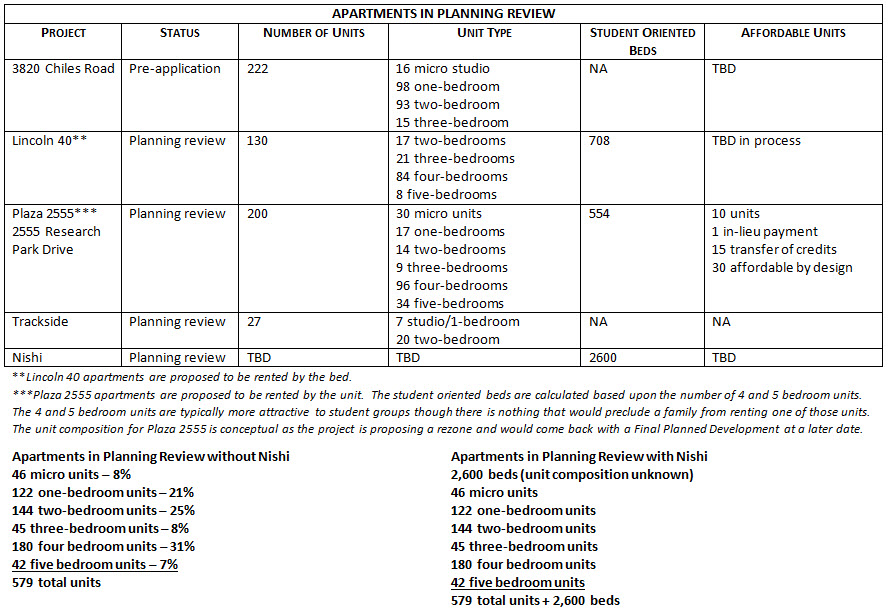

With all of the approved and now proposed projects for multifamily housing coming down the pike in Davis, it is helpful to be able to have a clear picture of what is being proposed and where.
The City of Davis and Ashley Feeney, Assistant Director of Community Development & Sustainability for the City of Davis, have generously put this chart together for the Vanguard.
We were able to get clarification on Plaza 25555 – a project that is currently in planning review and therefore any assessment is preliminary. Currently the plan is to get the General Plan Amendment and zoning change first, before general approval of the project.
At this time the project is anticipating 200 units. Those units break down as follows: 30 micro units, 17 one-bedrooms, 14 two-bedrooms, 9 three-bedrooms, 96 four-bedrooms and 34 five-bedrooms.
That means, of the 200 units, 120 (60 percent) are anticipated to be four- and five-bedroom units. That comes to roughly 554 student-oriented beds.
Ashley Feeney told the Vanguard, “Plaza 2555 is going to be rented by the unit instead of by the bed. They could rent to anyone. The four and five bedroom units are anticipated to be more student oriented by their nature though families could rent them.”

The current mix is broken down in the chart above. It shows that 397 total units have been approved. Of them, about 27 percent are four- and five-bedroom units while 63 percent are three-bedroom units or smaller, and 9 percent are currently unknown.

The units in planning tilt far more heavily toward student-oriented apartments.
Even then, 38 percent of the units that are pending (not counting Nishi) are four- and five-bedroom.
The unknown at this point is what the mix would be at Nishi. We know that the housing there is expected to have 2600 beds. What we do not know is what the unit composition will be.

There is some anticipation that there will be a student-oriented project at 525 Oxford Circle. However, according to Eric Lee, a planner with the city, “While we have met several times with owner reps about a project on this site, no formal planning application has been submitted. I do not have any specific information or plans that I can share. We expect an application at some point but the owners are still going through different concepts. Right now we are focused on trying to get the building demolished because of homeless and safety issues with the site.”
At this point there is no project, therefore, for either Oxford Circle or University Research Park.
The Count
Right now there have been 540 beds approved at Sterling.
Lincoln40 is current planning for 708 student beds. Plaza 2555, once again, does not have a fully defined project but anticipates 554 beds (but again, it is renting by the unit, not the room). And Nishi currently, without a firm project proposal, is projecting 2600 beds.
If everything were approved, that would be 1792 beds for the three larger apartment complexes excluding Nishi, which will also require a Measure R vote. And 4392 if Nishi got voter approval at 2600 units.
As we have noted previously, the university has committed to 6200 beds which would get the campus to 40 percent on-campus housing.
The city and others have pushed for 50 percent, which we project to mean the need for an additional 3800 beds or 10,000 total new beds.
The 4392 plus the 6200 would get us to just under 10,600 new beds.
—David M. Greenwald reporting

Some propositions regarding housing in Davis, presented in the form of statements for discussion (as done in debate):
1. There is a need, based on projected campus enrollment through 2027, for 10,000 more beds than we have in 2017.
2. The university will provide approximately 6200 of those. There is no evidence that they will provide any more than that.
3. The current apartment vacancy rate in Davis has been 0.2% in 2015 and 2016. It has been well below a healthy market rate for many years, and been getting worse.
4. The addition of 4400 more beds to private housing supply would keep the apartment vacancy rate from getting worse.
5. It would take more than 4400 beds to significantly improve the apartment vacancy rate.
6. Sterling, Lincoln 40, Plaza 2555 and Nishi combined would provide somewhat more than 4000 beds and keep the apartment vacancy rate from getting worse.
7. Any additional housing projects above those described already, as well as any additional housing on campus, could begin to improve the apartment vacancy rate.
Note: the actual apartment vacancy rate may fluctuate slightly, depending on the pace of enrollment increase, local population increase, and housing construction on and off campus.
I’m a little surprised this hasn’t generated more comments as it addresses a number of issues that have been raised over the last week. We get more of an answer about Plaza 2555 and it’s structure and also it paints a fuller picture of the housing that we have approved and is in the pipeline.
It’s because the answer doesn’t fit the narrative of the opponents.
That would be my conclusion as well… and it is ‘fact-based’ which gets in the way of rhetoric and half-truths.
David, Don, and Howard P,
Before you all jump to premature conclusions, not everyone, including myself is available everyday…all day…to respond to the Vanguard like you guys are. I had time just to respond to yesterday’s article before going out to get errands done and just got back. Yet, you three already are declaring some kind of victory, however, quite the contrary, this data is supports the points I have been making on this issue.
First of all David, your math is still significantly under-counting the number of student beds because you conveniently did not point in your last sentence out that your 4,392 does not include the Oxford Circle project which has been a student housing project from the time the City has know about it. In addition, the University Park project may be even more student beds. So, this project has got to be in the 400 or more student beds ballpark now. So even if the University Research Park apartments was not a student housing project that bring the count closer to 11,000 beds in the City for a 10,000 bed increase by UCD. And so the City would be also providing an additional 1000+ student beds in excess of the new UCD student population growth getting into the “backlog” of on-campus housing that UCD has needed to address over the decades of neglect. Therefore, the City continues to lose ground with housing for our families and workers with 5,000 more student only mega-dorm beds since UCD would just dial-back any on-campus housing they claim to “plan” on providing. The 5,000 student-only mega-dorm beds if built, would just enable UCD to continue pushing more and more students off campus, as they keep adding more students while they stall on building any new on-campus housing.
Second, the data shows that market-rate apartments are not being provided in any significant numbers for average families and income local workers who do not qualify for affordable housing. That is a major part of the problem that this deluge of mega-dorms proposals in the City. So, your percentages are not accurately representing the problem. In fact, they are very misleading. Although the affordable rental housing is a good thing, only low-income residents can qualify to live in them. So they do not provide the market rate rental housing needed by the many families and workers who are not in those lower income brackets.
The concern from the beginning has been about market-rate units and the fact that the mega-dorm market-rate design of 4- and 5- bedroom apartments do not help to provided the the rental housing needed for non-students like our families and workers, due to their exclusionary design.
First, didn’t jump to conclusions, rather felt this was important and wanted to draw attention to it.
Second, it’s not my math, this all came directly from the city.
Need to go to a memorial service, so signing off for now.